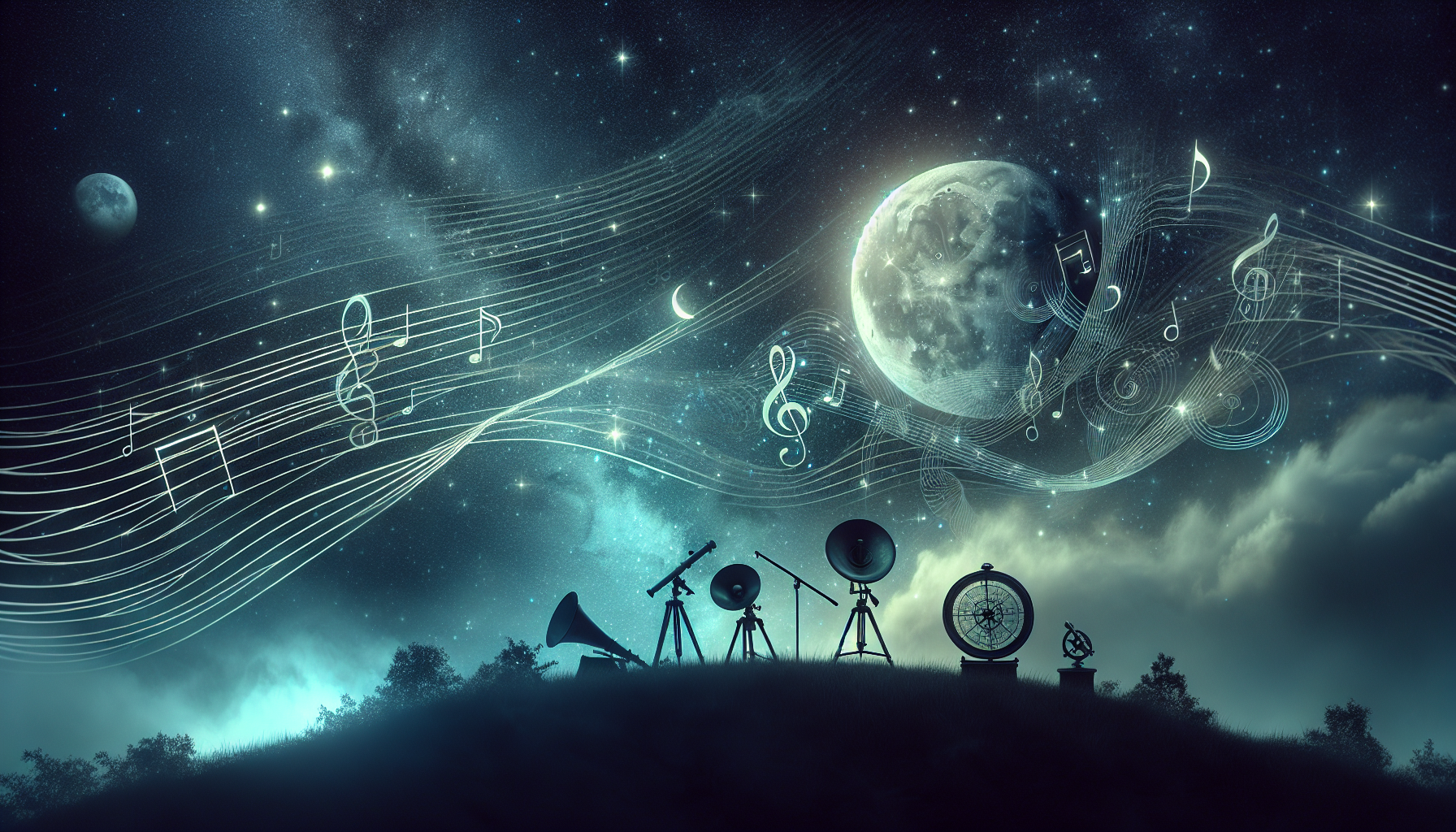Chapter 1: The Symphony of Silence
The universe was not as quiet as it seemed. Despite the immense voids and profound silences, there existed a music, a resonance that whispered through the cosmos. It was a melody played by the stars, an intricate dance of vibrations that had gone unnoticed by human ears for millennia.
In the year 2345, humanity’s understanding of the cosmos had reached new heights. With advanced technologies and insatiable curiosity, scientists had finally found a way to listen to the stars. They called it the Symphonic Array—a vast network of satellites designed to capture the celestial harmonies of the universe.
Dr. Elara Voss was the mastermind behind the Symphonic Array. A brilliant astrophysicist with a keen ear for music, she had spent her life developing the technology to convert cosmic vibrations into audible sound. For her, the universe was a great orchestra, and she was determined to decode its symphony.
As the Array began its first performance, Elara stood in the control room, her heart pounding with anticipation. The room was dark except for the glow of screens and the soft hum of machinery. She closed her eyes, waiting for the first notes of the universe to reach her ears.
And then, it happened. A low, resonant hum filled the room, a sound both alien and familiar. It was followed by a series of rising tones, a cadence that seemed to echo the very rhythm of the stars. Elara felt tears welling in her eyes as the music enveloped her, its beauty more profound than she had ever imagined.
Chapter 2: The Resonance Project
The discovery of celestial harmonies quickly sparked a new scientific endeavor named the Resonance Project. Spearheaded by Elara and supported by a global coalition of scientists and musicians, the project’s goal was to map the cosmic symphony and use it to unlock the secrets of the universe.
Elara’s team worked tirelessly, analyzing the melodies captured by the Symphonic Array. They found that each star system had its unique sound signature, a musical fingerprint composed of frequencies and rhythms. By cataloging these signatures, the team hoped to understand the underlying patterns of the cosmos.
As the data poured in, the team made a groundbreaking discovery. The celestial harmonies were not random; they followed mathematical patterns akin to complex symphonies composed by human musicians. This realization led to speculation that the universe itself might be a grand composition, orchestrated by forces yet to be understood.
Intrigued by the possibilities, Elara proposed a daring hypothesis: that the harmonies could be used to communicate with other civilizations. If humanity could interpret the cosmic music, they might be able to send messages across the stars, forging connections with alien species.
The idea was met with skepticism, but Elara’s passion and conviction were infectious. Soon, the Resonance Project expanded to include not only scientists but also linguists, mathematicians, and musicians. Together, they embarked on the quest to decode the language of the stars.
Chapter 3: A New Understanding
Months passed, and the Resonance Project made steady progress. The team discovered that the harmonies could be broken down into distinct elements, each representing different aspects of the universe’s structure. Some frequencies corresponded to the mass of celestial bodies, while others reflected their velocity and position.
Elara and her colleagues developed algorithms to translate these elements into musical notation, creating a cosmic score that could be studied and performed. They found that certain harmonies were repeated across different star systems, suggesting a shared cosmic language that transcended space and time.
As they delved deeper into the symphony, the team uncovered startling connections between the celestial music and the fundamental forces of nature. The harmonies seemed to echo the principles of quantum mechanics and relativity, hinting at a unified theory of the universe.
Inspired by these revelations, Elara proposed a radical experiment. By converting the musical score into electromagnetic signals, they could attempt to send a message across the cosmos, using the universal language of harmony to reach out to potential alien listeners.
The proposal sparked heated debates within the scientific community. Critics argued that such an experiment was reckless, potentially drawing attention from hostile civilizations. However, Elara believed that the potential rewards outweighed the risks. The chance to connect with other intelligent beings, to share in the cosmic symphony, was an opportunity too profound to ignore.
Chapter 4: The Cosmic Message
With the support of her team and a coalition of enthusiastic backers, Elara set the plan into motion. The Symphonic Array was reconfigured to broadcast the cosmic message, a carefully composed melody based on the harmonies of the stars. The message was designed to be simple yet profound, a greeting from humanity to the universe.
As the Array began its transmission, the world held its collective breath. Would the message be heard? And if so, would it be understood? Human history was filled with stories of first contact, but this was uncharted territory, a leap into the unknown.
Days turned into weeks, and weeks into months. The Array continued its broadcast, sending the celestial melody into the depths of space. Meanwhile, the Resonance Project remained vigilant, scanning the skies for any signs of a response.
Then, one fateful day, the silence was broken. The Symphonic Array detected a signal, a series of harmonies that echoed the original message. The team was ecstatic, their efforts rewarded with what appeared to be a reply from an alien civilization.
Elara and her colleagues worked feverishly to decode the signal. It was a complex composition, filled with unfamiliar rhythms and scales, yet it contained elements that resonated with the universal language they had discovered. Slowly but surely, they began to piece together the meaning of the message.
Chapter 5: The Celestial Choir
The response from the alien civilization was both surprising and enlightening. It was not a single message, but a symphony, a musical narrative that told the story of their species. The composition spoke of their history, their triumphs and struggles, and their own journey to understand the universe.
Elara and her team were awestruck by the beauty and complexity of the alien symphony. It was a testament to the power of music as a universal language, capable of conveying emotions and ideas that transcended cultural and biological differences.
As they delved deeper into the composition, the team made another astonishing discovery. Embedded within the alien symphony were harmonies that matched those of other star systems they had studied. It seemed that the alien civilization had also been listening to the cosmos, creating their own interpretation of the celestial symphony.
The revelation opened new avenues of exploration and collaboration. The Resonance Project reached out to the alien civilization, using the shared language of harmony to forge a connection. Together, they began to explore the mysteries of the universe, united by their love of music and their quest for knowledge.
The exchange marked the beginning of a new era, a celestial choir composed of voices from different worlds. It was a moment of profound significance, a testament to the power of music to bring people together, even across the vastness of space.
Chapter 6: Harmonies of the Future
Years passed, and the collaboration between humanity and the alien civilization flourished. Together, they expanded the Resonance Project, developing new technologies to explore the cosmos and uncover its secrets. The symphony of the universe continued to grow, a living composition that evolved with each new discovery.
Elara, now a revered figure in both civilizations, watched with pride as her dream became a reality. The universe was no longer a silent expanse, but a vibrant tapestry of sound and meaning. The celestial harmonies had become a bridge, connecting distant worlds and fostering a spirit of unity and understanding.
As the collaboration progressed, new civilizations joined the celestial choir, each bringing their unique melodies and perspectives. The universe was revealed to be a cosmic symphony, a harmonious interplay of voices that spanned galaxies and epochs.
With each new addition, the celestial music grew richer and more complex, a testament to the diversity and creativity of intelligent life. The Resonance Project continued to explore the depths of the cosmos, guided by the harmonies that had first inspired Elara and her team.
In the end, the universe was revealed to be more than just a collection of stars and planets. It was a symphony, a grand composition that embraced all of creation. And as humanity and its newfound allies journeyed together through the cosmos, they found solace and inspiration in the celestial harmonies that connected them all.
Chapter 7: The Eternal Symphony
As the celestial choir expanded, the musical exchanges transformed not only societal structures but also individual lives. People across worlds began to integrate the cosmic harmonies into their daily rituals, finding resonance and peace in their shared songs. Schools taught the music of the stars, and symphonies composed by interstellar collaborations echoed in concert halls and public spaces.
Elara often reflected on the journey that had begun with a single note from the Symphonic Array. Her work had not only transformed scientific understanding but had also ignited a cultural renaissance. The harmonies had become a living entity, evolving and adapting as more civilizations lent their voices to the grand composition.
One day, as she stood on the observation deck of the Array’s main station, Elara received a message from the alien civilization that had first responded to Earth’s call. They proposed a grand symphonic gathering, a convergence of all the worlds that had joined the celestial choir. The event would celebrate their shared achievements and foster deeper connections.
Elara embraced the idea, and soon preparations were underway. The gathering was to be held in the Alpha Quadrant, a region of space known for its vibrant star clusters and awe-inspiring nebulas. Representatives from each civilization embarked on a journey through the cosmos, converging on this symbolic location.
The gathering, named the “Eternal Symphony,” became a historic event. For the first time, beings from across the universe came together to perform a collective composition, a harmonious blend of their individual histories and dreams. It was a testament to the power of music to transcend boundaries and unite diverse cultures.
Chapter 8: A Universal Legacy
The success of the Eternal Symphony demonstrated the transformative power of the celestial harmonies. The participants returned to their worlds, inspired to continue the collaboration and share the lessons learned with future generations. The event became an annual tradition, a celebration of unity and diversity across the cosmos.
Elara’s legacy extended far beyond her original vision. The Resonance Project had laid the foundation for a new era of exploration and cooperation, guided by the principles of harmony and mutual respect. The celestial music served as a reminder of the interconnectedness of all life, encouraging societies to work together for the common good.
In her later years, Elara wrote extensively about her experiences and the impact of the celestial harmonies. Her writings were translated into countless languages, both human and alien, becoming a source of inspiration for generations to come.
As she gazed at the stars from her home on Earth, Elara felt a profound sense of fulfillment. Her life’s work had not only expanded humanity’s understanding of the universe but had also brought about a greater sense of connection among the stars.
And so, the celestial harmonies continued to resonate through the cosmos, a timeless symphony that embraced all of creation. In the vastness of space, the music of the stars played on, a testament to the power of harmony to unite and inspire across the ages.



